Yiyu Shi
AT-CXR: Uncertainty-Aware Agentic Triage for Chest X-rays
Aug 26, 2025Abstract:Agentic AI is advancing rapidly, yet truly autonomous medical-imaging triage, where a system decides when to stop, escalate, or defer under real constraints, remains relatively underexplored. To address this gap, we introduce AT-CXR, an uncertainty-aware agent for chest X-rays. The system estimates per-case confidence and distributional fit, then follows a stepwise policy to issue an automated decision or abstain with a suggested label for human intervention. We evaluate two router designs that share the same inputs and actions: a deterministic rule-based router and an LLM-decided router. Across five-fold evaluation on a balanced subset of NIH ChestX-ray14 dataset, both variants outperform strong zero-shot vision-language models and state-of-the-art supervised classifiers, achieving higher full-coverage accuracy and superior selective-prediction performance, evidenced by a lower area under the risk-coverage curve (AURC) and a lower error rate at high coverage, while operating with lower latency that meets practical clinical constraints. The two routers provide complementary operating points, enabling deployments to prioritize maximal throughput or maximal accuracy. Our code is available at https://github.com/XLIAaron/uncertainty-aware-cxr-agent.
HybridQ: Hybrid Classical-Quantum Generative Adversarial Network for Skin Disease Image Generation
Jun 26, 2025Abstract:Machine learning-assisted diagnosis is gaining traction in skin disease detection, but training effective models requires large amounts of high-quality data. Skin disease datasets often suffer from class imbalance, privacy concerns, and object bias, making data augmentation essential. While classical generative models are widely used, they demand extensive computational resources and lengthy training time. Quantum computing offers a promising alternative, but existing quantum-based image generation methods can only yield grayscale low-quality images. Through a novel classical-quantum latent space fusion technique, our work overcomes this limitation and introduces the first classical-quantum generative adversarial network (GAN) capable of generating color medical images. Our model outperforms classical deep convolutional GANs and existing hybrid classical-quantum GANs in both image generation quality and classification performance boost when used as data augmentation. Moreover, the performance boost is comparable with that achieved using state-of-the-art classical generative models, yet with over 25 times fewer parameters and 10 times fewer training epochs. Such results suggest a promising future for quantum image generation as quantum hardware advances. Finally, we demonstrate the robust performance of our model on real IBM quantum machine with hardware noise.
Unsupervised Out-of-Distribution Detection in Medical Imaging Using Multi-Exit Class Activation Maps and Feature Masking
May 13, 2025Abstract:Out-of-distribution (OOD) detection is essential for ensuring the reliability of deep learning models in medical imaging applications. This work is motivated by the observation that class activation maps (CAMs) for in-distribution (ID) data typically emphasize regions that are highly relevant to the model's predictions, whereas OOD data often lacks such focused activations. By masking input images with inverted CAMs, the feature representations of ID data undergo more substantial changes compared to those of OOD data, offering a robust criterion for differentiation. In this paper, we introduce a novel unsupervised OOD detection framework, Multi-Exit Class Activation Map (MECAM), which leverages multi-exit CAMs and feature masking. By utilizing mult-exit networks that combine CAMs from varying resolutions and depths, our method captures both global and local feature representations, thereby enhancing the robustness of OOD detection. We evaluate MECAM on multiple ID datasets, including ISIC19 and PathMNIST, and test its performance against three medical OOD datasets, RSNA Pneumonia, COVID-19, and HeadCT, and one natural image OOD dataset, iSUN. Comprehensive comparisons with state-of-the-art OOD detection methods validate the effectiveness of our approach. Our findings emphasize the potential of multi-exit networks and feature masking for advancing unsupervised OOD detection in medical imaging, paving the way for more reliable and interpretable models in clinical practice.
The Cost of Local and Global Fairness in Federated Learning
Mar 27, 2025

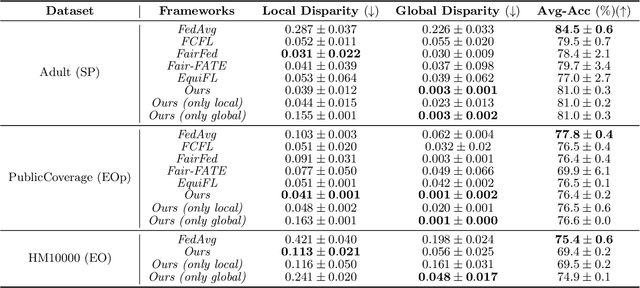

Abstract:With the emerging application of Federated Learning (FL) in finance, hiring and healthcare, FL models are regulated to be fair, preventing disparities with respect to legally protected attributes such as race or gender. Two concepts of fairness are important in FL: global and local fairness. Global fairness addresses the disparity across the entire population and local fairness is concerned with the disparity within each client. Prior fair FL frameworks have improved either global or local fairness without considering both. Furthermore, while the majority of studies on fair FL focuses on binary settings, many real-world applications are multi-class problems. This paper proposes a framework that investigates the minimum accuracy lost for enforcing a specified level of global and local fairness in multi-class FL settings. Our framework leads to a simple post-processing algorithm that derives fair outcome predictors from the Bayesian optimal score functions. Experimental results show that our algorithm outperforms the current state of the art (SOTA) with regard to the accuracy-fairness tradoffs, computational and communication costs. Codes are available at: https://github.com/papersubmission678/The-cost-of-local-and-global-fairness-in-FL .
Combating Partial Perception Deficit in Autonomous Driving with Multimodal LLM Commonsense
Mar 10, 2025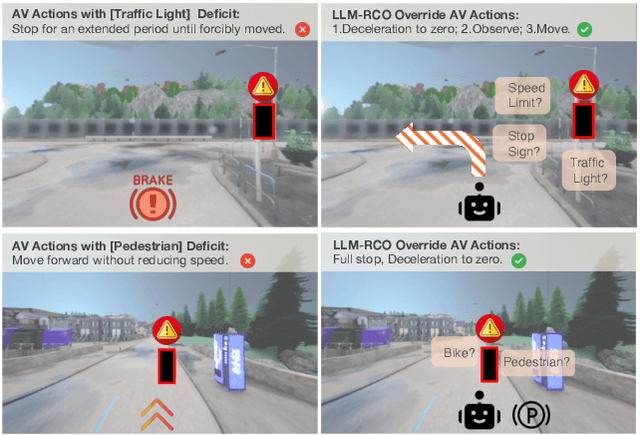
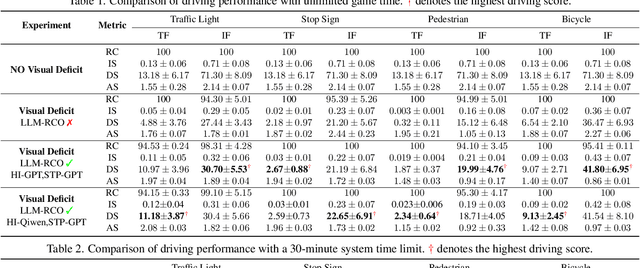
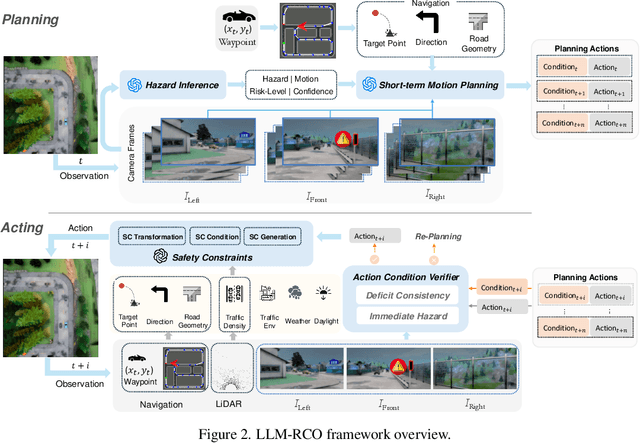
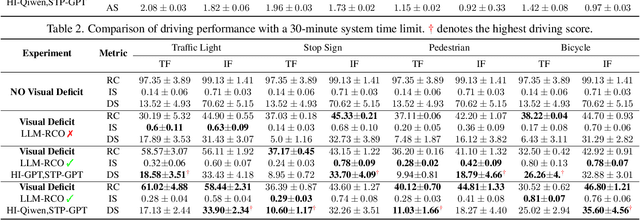
Abstract:Partial perception deficits can compromise autonomous vehicle safety by disrupting environmental understanding. Current protocols typically respond with immediate stops or minimal-risk maneuvers, worsening traffic flow and lacking flexibility for rare driving scenarios. In this paper, we propose LLM-RCO, a framework leveraging large language models to integrate human-like driving commonsense into autonomous systems facing perception deficits. LLM-RCO features four key modules: hazard inference, short-term motion planner, action condition verifier, and safety constraint generator. These modules interact with the dynamic driving environment, enabling proactive and context-aware control actions to override the original control policy of autonomous agents. To improve safety in such challenging conditions, we construct DriveLM-Deficit, a dataset of 53,895 video clips featuring deficits of safety-critical objects, complete with annotations for LLM-based hazard inference and motion planning fine-tuning. Extensive experiments in adverse driving conditions with the CARLA simulator demonstrate that systems equipped with LLM-RCO significantly improve driving performance, highlighting its potential for enhancing autonomous driving resilience against adverse perception deficits. Our results also show that LLMs fine-tuned with DriveLM-Deficit can enable more proactive movements instead of conservative stops in the context of perception deficits.
MPBD-LSTM: A Predictive Model for Colorectal Liver Metastases Using Time Series Multi-phase Contrast-Enhanced CT Scans
Dec 02, 2024Abstract:Colorectal cancer is a prevalent form of cancer, and many patients develop colorectal cancer liver metastasis (CRLM) as a result. Early detection of CRLM is critical for improving survival rates. Radiologists usually rely on a series of multi-phase contrast-enhanced computed tomography (CECT) scans done during follow-up visits to perform early detection of the potential CRLM. These scans form unique five-dimensional data (time, phase, and axial, sagittal, and coronal planes in 3D CT). Most of the existing deep learning models can readily handle four-dimensional data (e.g., time-series 3D CT images) and it is not clear how well they can be extended to handle the additional dimension of phase. In this paper, we build a dataset of time-series CECT scans to aid in the early diagnosis of CRLM, and build upon state-of-the-art deep learning techniques to evaluate how to best predict CRLM. Our experimental results show that a multi-plane architecture based on 3D bi-directional LSTM, which we call MPBD-LSTM, works best, achieving an area under curve (AUC) of 0.79. On the other hand, analysis of the results shows that there is still great room for further improvement.
Tiny-Align: Bridging Automatic Speech Recognition and Large Language Model on the Edge
Nov 21, 2024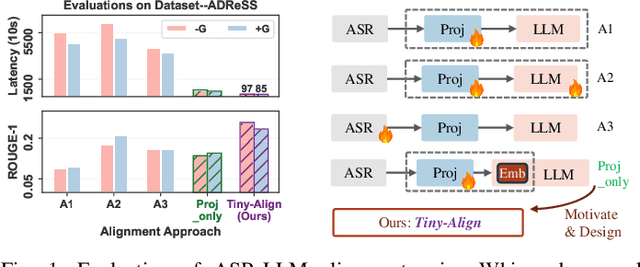
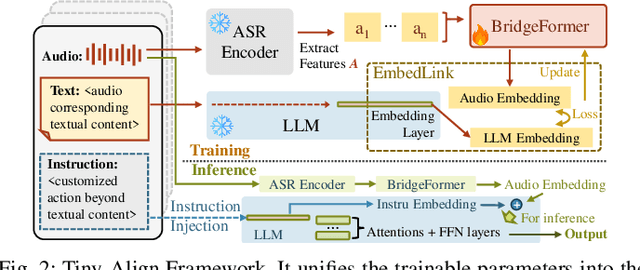
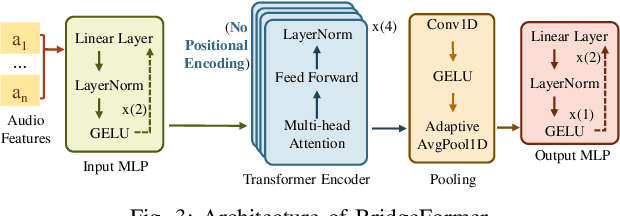
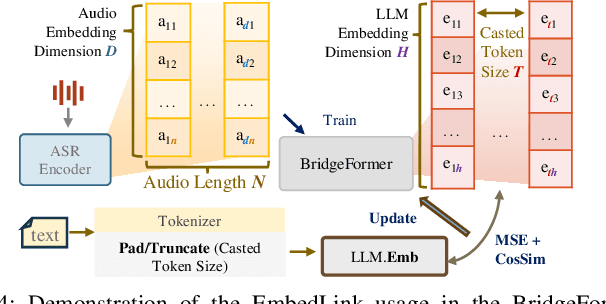
Abstract:The combination of Large Language Models (LLM) and Automatic Speech Recognition (ASR), when deployed on edge devices (called edge ASR-LLM), can serve as a powerful personalized assistant to enable audio-based interaction for users. Compared to text-based interaction, edge ASR-LLM allows accessible and natural audio interactions. Unfortunately, existing ASR-LLM models are mainly trained in high-performance computing environments and produce substantial model weights, making them difficult to deploy on edge devices. More importantly, to better serve users' personalized needs, the ASR-LLM must be able to learn from each distinct user, given that audio input often contains highly personalized characteristics that necessitate personalized on-device training. Since individually fine-tuning the ASR or LLM often leads to suboptimal results due to modality-specific limitations, end-to-end training ensures seamless integration of audio features and language understanding (cross-modal alignment), ultimately enabling a more personalized and efficient adaptation on edge devices. However, due to the complex training requirements and substantial computational demands of existing approaches, cross-modal alignment between ASR audio and LLM can be challenging on edge devices. In this work, we propose a resource-efficient cross-modal alignment framework that bridges ASR and LLMs on edge devices to handle personalized audio input. Our framework enables efficient ASR-LLM alignment on resource-constrained devices like NVIDIA Jetson Orin (8GB RAM), achieving 50x training time speedup while improving the alignment quality by more than 50\%. To the best of our knowledge, this is the first work to study efficient ASR-LLM alignment on resource-constrained edge devices.
NVCiM-PT: An NVCiM-assisted Prompt Tuning Framework for Edge LLMs
Nov 12, 2024



Abstract:Large Language Models (LLMs) deployed on edge devices, known as edge LLMs, need to continuously fine-tune their model parameters from user-generated data under limited resource constraints. However, most existing learning methods are not applicable for edge LLMs because of their reliance on high resources and low learning capacity. Prompt tuning (PT) has recently emerged as an effective fine-tuning method for edge LLMs by only modifying a small portion of LLM parameters, but it suffers from user domain shifts, resulting in repetitive training and losing resource efficiency. Conventional techniques to address domain shift issues often involve complex neural networks and sophisticated training, which are incompatible for PT for edge LLMs. Therefore, an open research question is how to address domain shift issues for edge LLMs with limited resources. In this paper, we propose a prompt tuning framework for edge LLMs, exploiting the benefits offered by non-volatile computing-in-memory (NVCiM) architectures. We introduce a novel NVCiM-assisted PT framework, where we narrow down the core operations to matrix-matrix multiplication, which can then be accelerated by performing in-situ computation on NVCiM. To the best of our knowledge, this is the first work employing NVCiM to improve the edge LLM PT performance.
A 10.60 $μ$W 150 GOPS Mixed-Bit-Width Sparse CNN Accelerator for Life-Threatening Ventricular Arrhythmia Detection
Oct 22, 2024



Abstract:This paper proposes an ultra-low power, mixed-bit-width sparse convolutional neural network (CNN) accelerator to accelerate ventricular arrhythmia (VA) detection. The chip achieves 50% sparsity in a quantized 1D CNN using a sparse processing element (SPE) architecture. Measurement on the prototype chip TSMC 40nm CMOS low-power (LP) process for the VA classification task demonstrates that it consumes 10.60 $\mu$W of power while achieving a performance of 150 GOPS and a diagnostic accuracy of 99.95%. The computation power density is only 0.57 $\mu$W/mm$^2$, which is 14.23X smaller than state-of-the-art works, making it highly suitable for implantable and wearable medical devices.
Contrastive Learning with Synthetic Positives
Aug 30, 2024Abstract:Contrastive learning with the nearest neighbor has proved to be one of the most efficient self-supervised learning (SSL) techniques by utilizing the similarity of multiple instances within the same class. However, its efficacy is constrained as the nearest neighbor algorithm primarily identifies ``easy'' positive pairs, where the representations are already closely located in the embedding space. In this paper, we introduce a novel approach called Contrastive Learning with Synthetic Positives (CLSP) that utilizes synthetic images, generated by an unconditional diffusion model, as the additional positives to help the model learn from diverse positives. Through feature interpolation in the diffusion model sampling process, we generate images with distinct backgrounds yet similar semantic content to the anchor image. These images are considered ``hard'' positives for the anchor image, and when included as supplementary positives in the contrastive loss, they contribute to a performance improvement of over 2\% and 1\% in linear evaluation compared to the previous NNCLR and All4One methods across multiple benchmark datasets such as CIFAR10, achieving state-of-the-art methods. On transfer learning benchmarks, CLSP outperforms existing SSL frameworks on 6 out of 8 downstream datasets. We believe CLSP establishes a valuable baseline for future SSL studies incorporating synthetic data in the training process.
 Add to Chrome
Add to Chrome Add to Firefox
Add to Firefox Add to Edge
Add to Edge